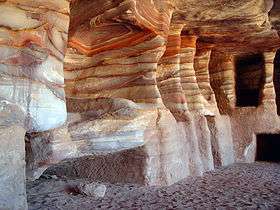Petra
| Petra Raqmu | |
|---|---|
|
Al Khazneh or The Treasury at Petra | |
| Location | Ma'an Governorate, Jordan |
| Coordinates | 30°19′43″N 35°26′31″E / 30.32861°N 35.44194°ECoordinates: 30°19′43″N 35°26′31″E / 30.32861°N 35.44194°E |
| Area | 264 square kilometres (102 sq mi)[1] |
| Elevation | 810 m (2,657 ft) |
| Built | possibly as early as 5th century BC [2] |
| Visitors | 596,602 (in 2014) |
| Governing body | Petra Region Authority |
| Type | Cultural |
| Criteria | i, iii, iv |
| Designated | 1985 (9th session) |
| Reference no. | 326 |
| State Party | Jordan |
| Region | Arab States |
| Website |
www |
 Location of Petra Raqmu in Jordan | |
Petra (Arabic: البترا, Al-Batrāʾ; Ancient Greek: Πέτρα), originally known as Raqmu to the Nabataeans, is a historical and archaeological city in the southern Jordanian governorate of Ma'an that is famous for its rock-cut architecture and water conduit system. Another name for Petra is the Rose City due to the color of the stone out of which it is carved.
Established possibly as early as 312 BC as the capital city of the Arab Nabataeans,[3] it is a symbol of Jordan, as well as Jordan's most-visited tourist attraction.[4] It lies on the slope of Jebel al-Madhbah (identified by some as the biblical Mount Hor[5]) in a basin among the mountains which form the eastern flank of Arabah (Wadi Araba), the large valley running from the Dead Sea to the Gulf of Aqaba. Petra has been a UNESCO World Heritage Site since 1985.
The site remained unknown to the western world until 1812, when it was introduced by Swiss explorer Johann Ludwig Burckhardt. It was described as "a rose-red city half as old as time" in a Newdigate Prize-winning poem by John William Burgon. UNESCO has described it as "one of the most precious cultural properties of man's cultural heritage".[6] Petra was named amongst the New7Wonders of the World in 2007 and was also chosen by the Smithsonian Magazine as one of the "28 Places to See Before You Die".[7]
Geography
Pliny the Elder and other writers identify Petra as the capital of the Nabataeans and the center of their caravan trade. Enclosed by towering rocks and watered by a perennial stream, Petra not only possessed the advantages of a fortress, but controlled the main commercial routes which passed through it to Gaza in the west, to Bosra and Damascus in the north, to Aqaba and Leuce Come on the Red Sea, and across the desert to the Persian Gulf.

Excavations have demonstrated that it was the ability of the Nabataeans to control the water supply that led to the rise of the desert city, creating an artificial oasis. The area is visited by flash floods and archaeological evidence demonstrates the Nabataeans controlled these floods by the use of dams, cisterns and water conduits. These innovations stored water for prolonged periods of drought and enabled the city to prosper from its sale.[8][9]
In ancient times, Petra might have been approached from the south on a track leading across the plain of Petra, around Jabal Haroun ("Aaron's Mountain"), the location of the Tomb of Aaron, said to be the burial-place of Aaron, brother of Moses. Another approach was possibly from the high plateau to the north. Today, most modern visitors approach the site from the east. The impressive eastern entrance leads steeply down through a dark, narrow gorge (in places only 3–4 m (9.8–13.1 ft) wide) called the Siq ("the shaft"), a natural geological feature formed from a deep split in the sandstone rocks and serving as a waterway flowing into Wadi Musa. At the end of the narrow gorge stands Petra's most elaborate ruin, Al Khazneh (popularly known as and meaning "the Treasury"), hewn into the sandstone cliff. While remaining in remarkably preserved condition, the face of the structure is marked by hundreds of bullet holes made by the local Bedouin tribes that hoped to dislodge riches that were once rumored to be hidden within it.[10]
A little farther from the Treasury, at the foot of the mountain called en-Nejr, is a massive theatre, positioned so as to bring the greatest number of tombs within view. At the point where the valley opens out into the plain, the site of the city is revealed with striking effect. The amphitheatre has been cut into the hillside and into several of the tombs during its construction. Rectangular gaps in the seating are still visible. Almost enclosing it on three sides are rose-colored mountain walls, divided into groups by deep fissures and lined with knobs cut from the rock in the form of towers.
History


By 7000 BC, some of the earliest recorded farmers had settled in Beidha, a pre-pottery settlement just north of Petra.[11] Petra is listed in Egyptian campaign accounts and the Amarna letters as Pel, Sela or Seir. Though the city was founded relatively late, a sanctuary has existed there since very ancient times. Stations 19 through 26 of the stations list of Exodus are places associated with Petra.[12] This part of the country was biblically assigned to the Horites, the predecessors of the Edomites.[13] The habits of the original natives may have influenced the Nabataean custom of burying the dead and offering worship in half-excavated caves. Although Petra is usually identified with Sela, which means a rock, the Biblical references[14] refer to it as "the cleft in the rock", referring to its entrance. In the parallel passage, however, Sela is understood to mean simply "the rock" (2 Chronicles xxv. 12, see LXX).
Josephus (Antiquities of the Jews iv. 7, 1~ 4, 7), Eusebius and Jerome (Onom. sacr. 286, 71. 145, 9; 228, 55. 287, 94) assert that Rekem was the native name, and this name appears in the Dead Sea Scrolls[15] as a prominent Edomite site most closely describing Petra, and associated with Mount Seir. But in the Aramaic versions, Rekem is the name of Kadesh, implying that Josephus may have confused the two places. The Semitic name of the city, if not Sela, remains unknown. The passage in Diodorus Siculus (xix. 94–97) which describes the expeditions which Antigonus sent against the Nabataeans in 312 BC is understood to throw some light upon the history of Petra, but the "petra" referred to as a natural fortress and place of refuge cannot be a proper name and the description implies that the town was not yet in existence.

Rekem is likely derived from the Nabataean name for the city, Raqmu.
The name "Rekem" was inscribed in the rock wall of the Wadi Musa opposite the entrance to the Siq,[16] However, Jordan built a bridge over the wadi and this inscription was buried beneath tons of concrete.[17]
More satisfactory evidence of the date of the earliest Nabataean settlement may be obtained from an examination of the tombs. Two types of tombs have been distinguished: the Nabataean and the Greco-Roman. The Nabataean type starts from the simple pylon-tomb with a door set in a tower crowned by a parapet ornament, in imitation of the front of a dwelling-house. Then, after passing through various stages, the full Nabataean type is reached, retaining all the native features and at the same time exhibiting characteristics which are partly Egyptian and partly Greek. Of this type close parallels exist in the tomb-towers at Mada'in Saleh in north Arabia, which bear long Nabataean inscriptions and supply a date for the corresponding monuments at Petra. Then comes a series of tombfronts which terminate in a semicircular arch, a feature derived from north Syria. Finally come the elaborate façades copied from the front of a Roman temple; however, all traces of native style have vanished. The exact dates of the stages in this development cannot be fixed. Few inscriptions of any length have been found at Petra, perhaps because they have perished with the stucco or cement which was used upon many of the buildings. The simple pylon-tombs which belong to the pre-Hellenic age serve as evidence for the earliest period. It is not known how far back in this stage the Nabataean settlement goes, but it does not go back farther than the 6th century BC. A period follows in which the dominant civilization combines Greek, Egyptian and Syrian elements, clearly pointing to the age of the Ptolemies. Towards the close of the 2nd century BC, when the Ptolemaic and Seleucid kingdoms were equally depressed, the Nabataean kingdom came to the front. Under Aretas III Philhellene, (c.85–60 BC), the royal coins begin. The theatre was probably excavated at that time, and Petra must have assumed the aspect of a Hellenistic city. In the reign of Aretas IV Philopatris, (9 BC–40 AD), the tombs of the el-I~ejr type may be dated, and perhaps also the High-place.
Roman rule
In 106 AD, when Cornelius Palma was governor of Syria, the part of Arabia under the rule of Petra was absorbed into the Roman Empire as part of Arabia Petraea and became its capital. The native dynasty came to an end but the city continued to flourish under Roman rule. It was around this time that the Petra Roman Road was built. A century later, in the time of Alexander Severus, when the city was at the height of its splendor, the issue of coinage comes to an end. There is no more building of sumptuous tombs, owing apparently to some sudden catastrophe, such as an invasion by the neo-Persian power under the Sassanid Empire. Meanwhile, as Palmyra (fl. 130–270) grew in importance and attracted the Arabian trade away from Petra, the latter declined. It appears, however, to have lingered on as a religious centre. Another Roman road was constructed at the site. Epiphanius of Salamis (c.315–403) writes that in his time a feast was held there on December 25 in honor of the virgin Khaabou (Chaabou) and her offspring Dushara (Haer. 51).
Byzantine era – decline
Petra declined rapidly under Roman rule, in large part from the revision of sea-based trade routes. In 363 an earthquake destroyed many buildings, and crippled the vital water management system.[18] The last inhabitants abandoned the city (further weakened by another major earthquake in 551) when the Arabs conquered the region in 663. The old city of Petra was the capital of the Byzantine province Palaestina III, many churches were excavated in and around Petra from the Byzantine era, in one of them more than 150 papyrus were discovered which contain mainly contracts. The ruins of Petra were an object of curiosity in the Middle Ages and were visited by Sultan Baibars of Egypt towards the end of the 13th century. The first European to describe them was Swiss traveller Johann Ludwig Burckhardt during his travels in 1812.[19] At that time, the Greek Church of Jerusalem operated a diocese in Al Karak named Battra (ﻩﺮﻃﺎﺑ in Arabic, and Πέτρας in Greek) and it was the opinion among the clergy of Jerusalem that Kerak was the ancient Petra.[19]
Because the structures weakened with age, many of the tombs became vulnerable to thieves, and many treasures were stolen. In 1929, a four-person team, consisting of British archaeologists Agnes Conway and George Horsfield, Palestinian physician and folklore expert Dr Tawfiq Canaan and Dr Ditlef Nielsen, a Danish scholar, excavated and surveyed Petra.[20]
T. E. Lawrence

In October 1917, as part of a general effort to divert Ottoman military resources away from the British advance before the Third Battle of Gaza, a revolt of Arabs in Petra was led by British Army officer T. E. Lawrence (Lawrence of Arabia) against the Ottoman regime. The Bedouin women living in the vicinity of Petra and under the leadership of Sheik Khallil's wife were gathered to fight in the revolt of the city. The rebellions, with the support of English military, were able to devastate the Ottoman forces.[21]
Late Twentieth Century: World Heritage Site Designation

The Bidoul/ Bidul or Petra Bedouin were forcibly resettled from their cave dwellings in Petra to Umm Sayhoun/ Um Seihun by the Jordanian government in 1985, prior to the UNESCO designation process. Here, they were provided with block-built housing with some infrastructure including in particular a sewage and drainage system. Among the six communities in the Petra Region, Umm Sayhoun is one of the smaller communities. The village of Wadi Musa is the largest in the area, inhabited largely by the Layathnah Bedouin, and is now the closest settlement to the visitor centre, the main entrance via the Siq and the archaeological site generally. Umm Sayhoun gives access to the 'back route' into the site, the Wadi Turkmaniyeh pedestrian route.[22]
On December 6, 1985, Petra was designated a World Heritage Site.
The Bidouls belong to one of the Bedu tribes whose cultural heritage and traditional skills was proclaimed by UNESCO on the Intangible Cultural Heritage List in 2005 and inscribed[23] in 2008.
In 2011, following an 11-month project planning phase, the Petra Development and Tourism Region Authority in Association with DesignWorkshop and JCP s.r.l published a Strategic Master Plan that guides planned development of the Petra Region. This is intended to guide planned development of the Petra Region in an efficient, balanced and sustainable way over the next 20 years for the benefit of the local population and of Jordan in general. As part of this, a Strategic Plan was developed for Umm Sayhoun and surrounding areas.[24]
The process of developing the Strategy considered the area's needs from five points of view:
- a socio-economic perspective;
- the perspective of Petra Archaeological Park;
- the perspective of Petra’s tourism product;
- a land use perspective;
- an environmental perspective
Petra today
27 sites in Petra are now available on Google Street View.[25]
Threats to Petra
The site suffers from a host of threats, including collapse of ancient structures, erosion due to flooding and improper rainwater drainage, weathering from salt upwelling,[26] improper restoration of ancient structures, and unsustainable tourism.[27] The last has increased substantially, especially since the site received widespread media coverage in 2007 during the New Seven Wonders of the World Internet and cell phone campaign.[28]
In an attempt to reduce the impact of these threats, Petra National Trust (PNT) was established in 1989. Over this time, it has worked together with numerous local and international organizations on projects that promote the protection, conservation and preservation of the Petra site.[29] Moreover, UNESCO and ICOMOS recently collaborated to publish their first book on human and natural threats to these sensitive World Heritage sites. They chose Petra as its first, and the most important example of threatened landscapes. A book released in 2012, Tourism and Archaeological Heritage Management at Petra: Driver to Development or Destruction?, was the first in a series of important books to address the very nature of these deteriorating buildings, cities, sites, and regions.[30] The next books in the series of deteriorating UNESCO World Heritage Sites will include Macchu Picchu, Angkor Wat, and Pompeii.

Religion

The Nabataeans worshipped Arab gods and goddesses of the pre-Islamic times as well as a few of their deified kings. One, Obodas I, was deified after his death. Dushara was the primary male god accompanied by his female trinity: Al-‘Uzzá, Allat and Manāt. Many statues carved in the rock depict these gods and goddesses. New evidence indicates that broader Edomite, and Nabataean theology had strong links to Earth-Sun relationships, often manifested in the orientation of prominent Petra structures to equinox and solstices sunrises and sunsets.[31]
A stele is dedicated to Qos-Allah 'Qos is Allah' or 'Qos the god', by Qosmilk (melech – king) is found at Petra (Glueck 516). Qos is identifiable with Kaush (Qaush) the God of the older Edomites. The stele is horned and the seal from the Edomite Tawilan near Petra identified with Kaush displays a star and crescent (Browning 28), both consistent with a moon deity. It is conceivable the latter could have resulted from trade with Harran (Bartlett 194). There is continuing debate about the nature of Qos (qaus – bow) who has been identified both with a hunting bow (hunting god) and a rainbow (weather god) although the crescent above is also a bow.
Nabatean inscriptions in Sinai and other places display widespread references to names including Allah, El and Allat (god and goddess), with regional references to al-Uzza, Baal and Manutu (Manat) (Negev 11). Allat is also found in Sinai in South Arabian language. Allah occurs particularly as Garm-'allahi – god dedided (Greek Garamelos) and Aush-allahi – 'gods covenant' (Greek Ausallos). We find both Shalm-lahi 'Allah is peace' and Shalm-allat, 'the peace of the goddess'. We also find Amat-allahi 'she-servant of god' and Halaf-llahi 'the successor of Allah'.[32]
The Monastery, Petra's largest monument, dates from the 1st century BC. It was dedicated to Obodas I and is believed to be the symposium of Obodas the god. This information is inscribed on the ruins of the Monastery (the name is the translation of the Arabic "Ad Deir").
Christianity found its way to Petra in the 4th century AD, nearly 500 years after the establishment of Petra as a trade center. Athanasius mentions a bishop of Petra (Anhioch. 10) named Asterius. At least one of the tombs (the "tomb with the urn"?) was used as a church. An inscription in red paint records its consecration "in the time of the most holy bishop Jason" (447). After the Islamic conquest of 629–632 Christianity in Petra, as of most of Arabia, gave way to Islam. During the First Crusade Petra was occupied by Baldwin I of the Kingdom of Jerusalem and formed the second fief of the barony of Al Karak (in the lordship of Oultrejordain) with the title Château de la Valée de Moyse or Sela. It remained in the hands of the Franks until 1189. It is still a titular see of the Catholic Church.[33]
Two Crusader-period castles are known in and around Petra. The first is al-Wu'ayra and is situated just north of Wadi Musa. It can be viewed from the road to "Little Petra". It is the castle of Valle Moise which was seized by a band of Turks with the help of local Muslims and only recovered by the Crusaders after they began to destroy the olive trees of Wadi Musa. The potential loss of livelihood led the locals to negotiate surrender. The second is on the summit of el-Habis in the heart of Petra and can be accessed from the West side of the Qasr al-Bint.
According to Arab tradition, Petra is the spot where Moses (Musa) struck a rock with his staff and water came forth, and where Moses' brother, Aaron (Harun), is buried, at Mount Hor, known today as Jabal Haroun or Mount Aaron. The Wadi Musa or "Wadi of Moses" is the Arab name for the narrow valley at the head of which Petra is sited. A mountaintop shrine of Moses' sister Miriam was still shown to pilgrims at the time of Jerome in the 4th century, but its location has not been identified since.[34]
In popular culture
Literature
Petra is the main topic in John William Burgon's sonnet (rhyme scheme aabbccddeeffgg) "Petra" which won the Newdigate Prize in 1845. The poem refers to Petra as the inaccessible city which he had heard described but had never seen:
It seems no work of Man's creative hand,by labour wrought as wavering fancy planned;
- But from the rock as if by magic grown,
eternal, silent, beautiful, alone!
- Not virgin-white like that old Doric shrine,
where erst Athena held her rites divine;
- Not saintly-grey, like many a minster fane,
that crowns the hill and consecrates the plain;
- But rose-red as if the blush of dawn,
that first beheld them were not yet withdrawn;
- The hues of youth upon a brow of woe,
which Man deemed old two thousand years ago,
- match me such marvel save in Eastern clime,
a rose-red city half as old as time.
Petra appeared in the novels Left Behind Series, Appointment with Death, The Eagle in the Sand, The Red Sea Sharks, the nineteenth book in The Adventures of Tintin series and in Kingsbury's The Moon Goddess and the Son. It featured prominently in the Marcus Didius Falco mystery novel Last Act in Palmyra. In Blue Balliett's novel, Chasing Vermeer, the character Petra Andalee is named after the site.[35]
In 1979 Marguerite van Geldermalsen from New Zealand married Mohammed Abdullah, a Bedouin in Petra.[36] They lived in a cave in Petra until the death of her husband. She authored the book Married to a Bedouin. Van Geldermalsen is the only western woman who has ever lived in a Petra cave.
An Englishwoman, Joan Ward, wrote Living With Arabs: Nine Years with the Petra Bedouin[37] documenting her experiences while living in Umm Sayhoun with the Petra Bedouin, covering the period 2004-2013.
Films
The site is featured in films such as: Indiana Jones and the Last Crusade, Arabian Nights, Passion in the Desert, Mortal Kombat: Annihilation, Sinbad and the Eye of the Tiger, The Mummy Returns and Transformers: Revenge of the Fallen.
TV
Petra was featured in episode 3 of the 2010 series An Idiot Abroad.
Petra was featured in episode 20 of Misaeng (TV series).[38][39]
Petra was featured in an episode of Time Scanners, made for National Geographic, where six ancient structures were laser scanned, with the results built into 3D models.[40] Examining the model of Petra revealed insights into how the structure was built.[41]
Petra was the focus of an American PBS NOVA special, Petra: Lost City of Stone,[42] which premiered in the US and Europe in February 2015.
Plays
Playwright John Yarbrough's tragicomedy, Petra,[43] debuted at the Manhattan Repertory Theatre in 2014[44] and was followed by award-winning performances at the Hudson Guild in New York in 2015.[45]
Music and Music Videos
The power metal band, Helloween, featured Petra on their 2013 track "Nabataea" off their album, Straight Out of Hell.
In 1977, the Lebanese Rahbani brothers wrote the musical "Petra" as a response to the Lebanese Civil War.[46]
The Sisters of Mercy filmed their music video for "Dominion/Mother Russia" in and around Al Khazneh ("The Treasury") in February 1988.[47]
In 1994 Petra featured in the video to the Urban Species video Spiritual Love.[48]
Video Games
It was recreated for the video games Spy Hunter (2001), King's Quest V, Lego Indiana Jones, Sonic Unleashed, Knights of the Temple: Infernal Crusade and Civilization V.
Sister cities
Gallery
-

Al Khazneh / The Treasury at Petra
-

The road to the Siiq
-
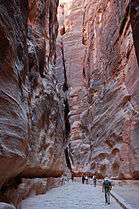
The Siiq, path to Petra
-

El Deir ("The Monastery")
-

Byzantine mosaic in the Byzantine Church of Petra
-
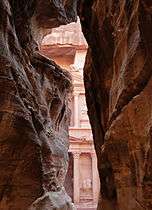
The end of the Siq, with its dramatic view of Al Khazneh ("The Treasury")
-
The Hadrian Gate and the Cardo Maximus in Petra
-

Petra is known as the Rose-Red City[1] for the colour of the rocks from which Petra is carved
-
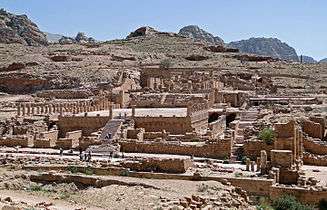
The Great Temple of Petra
-
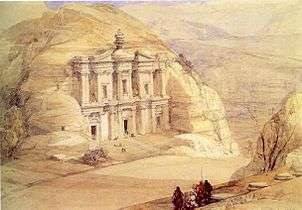
Ad Deir ("The Monastery") in 1839, by David Roberts
-
The Petra Visitors Centre in Wadi Musa, the closest town to the historic site
-

Drimia maritima bulbs in Petra in early December (2010)
-

Obelisk Tomb and the Triclinium
-

Street of Façades
-

The Silk Tomb
-
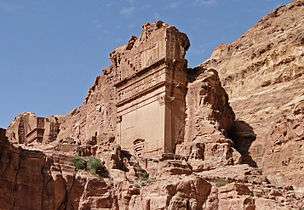
Uneishu Tomb
-

Juniperus phoenicea in Petra
-
Lonely cave
-

Sandstone rocks in Siq
-

Main entrance (Al Khazneh)
-

Theatre
-
General view
-

Ancient columns of the Great Temple
-
Tourist attraction
- ^ "The Rose-Red City of Petra publisher=Grisel.net". 2001-04-26. Retrieved 2012-04-17.
See also
- Arabia Petraea
- List of colossal sculpture in situ
- Little Petra
- Mada'in Saleh
- Negev incense route
- Petra papyri
- UNESCO Intangible Cultural Heritage Lists
- List of World Heritage Sites in Jordan
Notes
- ↑ "Management of Petra". Petra National Trust. Retrieved 14 April 2015.
- ↑ Browning, Iain (1973, 1982), Petra, Chatto & Windus, London, p. 15, ISBN 0-7011-2622-1
- ↑ Seeger, Josh; Gus W. van Beek (1996). Retrieving the Past: Essays on Archaeological Research and Methodolog. Eisenbrauns. p. 56. ISBN 978-1575060125.
- ↑ Major Attractions: Petra, Jordan tourism board
- ↑ Mish, Frederick C., Editor in Chief. "Petra". Webster’s Ninth New Collegiate Dictionary. 9th ed. Springfield, Massachusetts: Merriam-Webster Inc., 1985. ISBN 0-87779-508-8.
- ↑ "UNESCO advisory body evaluation" (PDF). Retrieved 2011-12-05.
- ↑ "28 Places to See Before You Die. Smithsonian Magazine". Smithsonianmag.com. Retrieved 2014-02-06.
- ↑ "Petra: Water Works". Nabataea.net. Retrieved 2011-12-05.
- ↑ Lisa Pinsker (2001-09-11). "Geotimes – June 2004 – Petra: An Eroding Ancient City". Agiweb.org. Retrieved 2011-12-05.
- ↑ "Robert Fulford's column about Petra, Jordan". Robertfulford.com. 1997-06-18. Retrieved 2014-02-06.
- ↑ "A Short History". Petra National Foundation. Retrieved 13 February 2014.
- ↑
- 25. Mithcah – Nu. 33:28–29 associated with Petra on the borders of Moab and Edom near Petra.
- 26. Hashmonah – Nu. 33:29–30 Ha Shmona Kiryat Shmona South
- 27. Moseroth – Nu. 33:30–31 described as the place where Aaron died at the foot of Mt Hor (Petra)
- 28. Bene-Jaakan – Nu. 33:31–32 the wells of Jaakan Near Mt Hor (Petra)
- 29. Petra – Nu. 33:32–33 Siq The cleft of the mountain, the entrance to Petra
- ↑ Genesis xiv. 6, xxxvi. 20–30; Deut. ii. 12.
- ↑ Judges i. 36; Isaiah xvi. i, xlii. 11; Obad. 3.
- ↑ 4Q462
- ↑ Iain Browning, Petra, Chatto & Windus, 1974. p. 109.
- ↑ "History of Petra". Terhaal Adventures. Retrieved 2015-09-10.
- ↑ Glueck, Grace (2003-10-17). "ART REVIEW; Rose-Red City Carved From the Rock". The New York Times. Retrieved 2010-05-22.
- 1 2 John Lewis Burckhardt (1822). Travels in Syria and the Holy Land. J. Murray.
- ↑ Conway, A. and Horsfield, G. 1930. Historical and Topographical Notes on Edom: with an account of the first excavations at Petra. The Geographical Journal, 76 (5), 369–390.
- ↑ Thomas, Lowell, With Lawrence in Arabia, The Century Co., 1924, pps. 180–187
- ↑ "Map of the area from the go2petra website".
- ↑ "The Cultural Space of the Bedu in Petra and Wadi Rum". UNESCO Culture Sector. Retrieved 2015-06-02.
- ↑ Petra Development and Tourism Region Authority in Association with DesignWorkshop and JCP s.r.l: Strategic Plan for Umm Sayhoun and surrounding areas
- ↑ http://www.google.com/maps/streetview/#petra
- ↑ Heinrichs, K., Azzam, R.: "Investigation of salt weathering on stone monuments by use of a modern wireless sensor network exemplified for the rock-cut monuments in Petra / Jordan – a research project International Journal of Heritage in the Digital Era, Volume 1, Nr. 2 / Juni 2012, S. 191–216
- ↑ Icomos.org, Heritage at Risk 2004/2005: Petra
- ↑ "Heritage Conservation Grips Jordan's Petra Amid Booming Tourism". Xinhua. November 3, 2007.
- ↑ "Petra National Trust-About". Petranationaltrust.org. Retrieved 2011-12-05.
- ↑ Comer and Willems. "Tourism and Archaeological Heritage Management at Petra: Driver to Development or Destruction?" (PDF). Retrieved 2015-09-10.
- ↑ Paradise T.R. & Angel C.C. 2015, Nabatean Architecture and the Sun, ArcUser (Winter).
- ↑ Negev 11
- ↑
 "Petra". Catholic Encyclopedia. New York: Robert Appleton Company. 1913.
"Petra". Catholic Encyclopedia. New York: Robert Appleton Company. 1913. - ↑ "Petra". Sacred Sites. Retrieved 2011-12-05.
- ↑ Balliett, Blue (2004). Chasing Vermeer: Afterwords by Leslie Budnick: Author Q&A. Scholastic. ISBN 0-439-37294-1.
- ↑ Geldermalsen, Marguerite (2010). Married to a Bedouin. Virago UK. ISBN 978-1844082209.
- ↑ Ward, Joan (2014). Living With Arabs: Nine Years with the Petra Bedouin. UM Peter Publishing. ISBN 978-1502564917.
- ↑ "Scenes for TV drama series ‘Misaeng’ shot around Kingdom.The Jordan Times". The Jordan Times.
- ↑ "Misaeng Episode 20 Final". dramabeans.com.
- ↑
- ↑
- ↑ Petra-Lost City in building-wonders at pbs.org
- ↑ "John Yarborough's Petra on Youtube".
- ↑ "Manhattan Repertory Theatre fall one act competition 2014 including John Yarborough's Petra". Retrieved 2015-06-04.
- ↑ "Broadwayworld, Off-Off-Broadway, article: 'Playwright John Yarbrough Wins Strawberry One Act Festival'". Retrieved 2015-06-04.
- ↑ Stone, Christopher. Popular Culture and Nationalism in Lebanon.
- ↑ imdb.com page for The Sisters of Mercy
- ↑ Urban Species Spiritual Love music video at nme.com
References
- Bedal, Leigh-Ann (2004). The Petra Pool-Complex: A Hellenistic Paradeisos in the Nabataean Capital. Piscataway, NJ: Gorgias Press. ISBN 1-59333-120-7.
- Harty, Rosemary. "The Bedouin Tribes of Petra Photographs: 1986–2003". Retrieved 2008-07-17.
- Hill, John E. (2004). The Peoples of the West from the Weilue 魏略 by Yu Huan 魚豢 : A Third Century Chinese Account Composed between 239 and 265 CE.
Draft annotated English translation where Petra is referred to as the Kingdom of Sifu.
- Paradise, T. R. (2011). "Architecture and Deterioration in Petra: Issues, trends and warnings" in Archaeological Heritage at Petra: Drive to Development or Destruction?" (Doug Comer, editor), ICOMOS-ICAHM Publications through Springer-Verlag NYC: 87–119.
- Paradise, T. R. (2005). "Weathering of sandstone architecture in Petra, Jordan: influences and rates" in GSA Special Paper 390: Stone Decay in the Architectural Environment: 39–49.
- Paradise, T. R. and Angel, C. C. (2015). Nabataean Architecture and the Sun: A landmark discovery using GIS in Petra, Jordan. ArcUser Journal, Winter 2015: 16-19pp.
- Reid, Sara Karz (2006). The Small Temple. Piscataway, NJ: Gorgias Press. ISBN 1-59333-339-0.
Reid explores the nature of the small temple at Petra and concludes it is from the Roman era.
- Nelson Glueck (1959). Rivers in the Desert. HUC.
 This article incorporates text from a publication now in the public domain: Chisholm, Hugh, ed. (1911). Encyclopædia Britannica (11th ed.). Cambridge University Press.
This article incorporates text from a publication now in the public domain: Chisholm, Hugh, ed. (1911). Encyclopædia Britannica (11th ed.). Cambridge University Press.- UNESCO World Heritage Centre. "Petra." Accessed April 19, 2013. http://whc.unesco.org/en/list/326.
- Brown University. "The Petra Great Temple | History." Accessed April 19, 2013. http://www.brown.edu/Departments/Joukowsky_Institute/Petra/excavations/history.html.
- AtlasTours.Net – Visit Middle East: Jordan, Holyland, Syria, Lebanon, Iraq, Sinai (Egypt). "Petra, Jordan." Accessed April 19, 2013. http://www.atlastours.net/jordan/petra.html.
- Michel Mouton, Stephen G. Schmid (2013) "Men on the Rocks: The Formation of Nabataean Petra"
External links
| Wikimedia Commons has media related to Petra, Jordan. |
| Wikivoyage has a travel guide for Petra. |
- Video overview of Petra
- Petra In The Early 1800s
- 3D-tour on Petra (Russian)
- Petra Archaeological Park
- University of Arkansas Petra Project: http://geosciences.uark.edu/217.php
- Petra Restaurant in Louisiana
- Smart e Guide, interactive map of Petra
- Biblical Archaeology Society, "Solving the Enigma of Petra and the Nabataeans", Biblical Archaeology Review
- Open Context, "Petra Great Temple Excavations (Archaeological Data)", Open Context Publication of Archaeological Data from the 1993–2006 Brown University Excavations at the Great Temple of Petra, Jordan
- Petra iconicarchive, photo gallery
- Petra – photo gallery
- Petra History and Photo Gallery History with Maps
- Parker, S., R. Talbert, T. Elliott, S. Gillies, S. Gillies, J. Becker. "Places: 697725 (Petra)". Pleiades. <http://pleiades.stoa.org/places/697725> [Accessed: March 7, 2012 4:18 pm]
- Pictures on Petra
- Almost 800 pictures with captions, some panoramas
- Petra, HD video
- Jordanian Ministry of Tourism and Antiquities
| ||||||||||||||||||||||||||||||||||||||||||||||||||
| ||||||||||||||||||
| |||||||||||||||||||||||||||||
|
